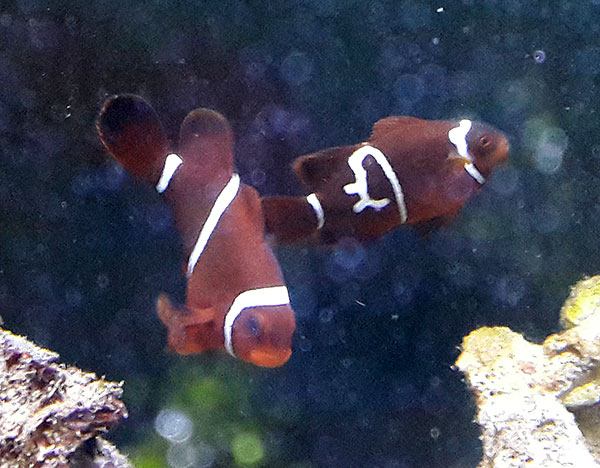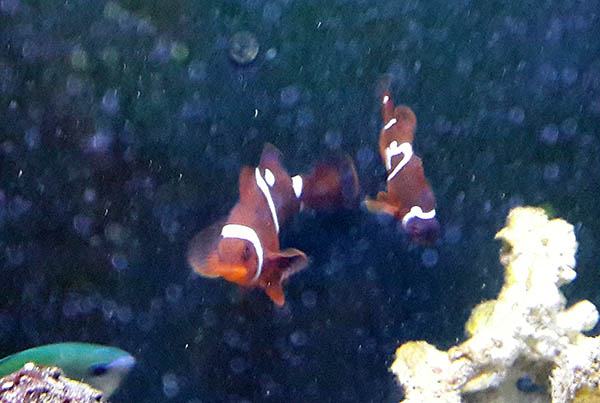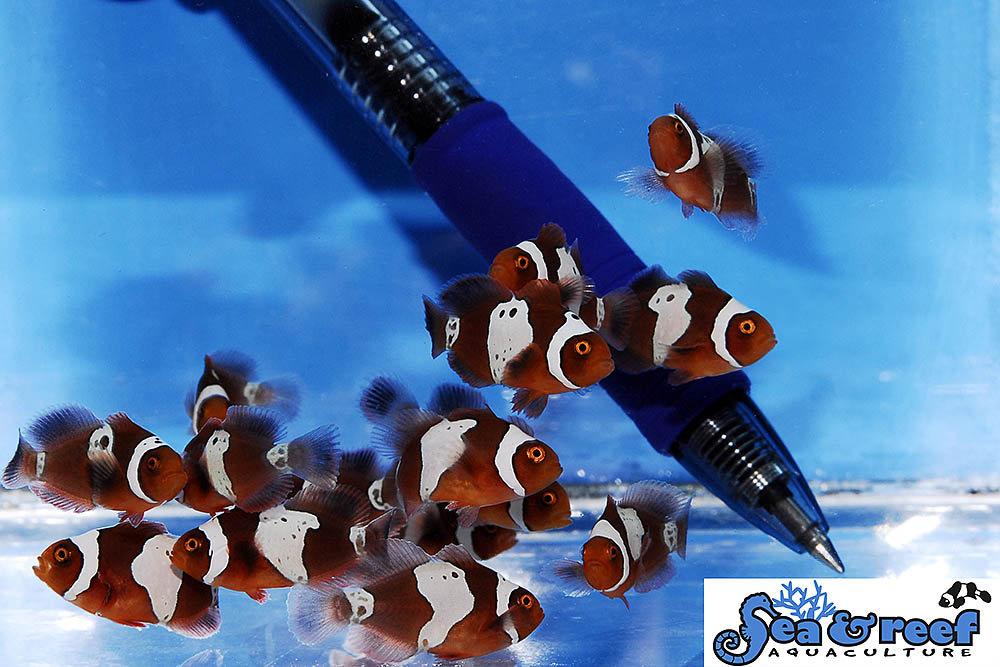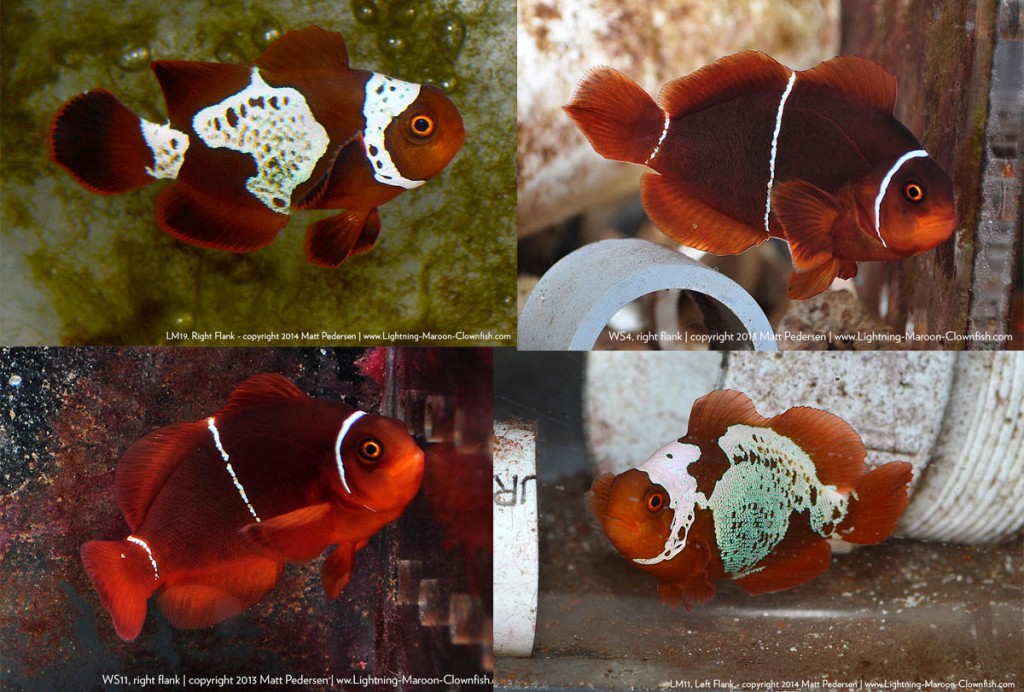After a lot of downtime, the Lightning Maroon Clownfish F0 pair settled back in and put down a SMALL nest yesterday, in the afternoon of 8-30-2014. This after a couple tile house collapses and such, combined with a diet change, which put them off for a few weeks. Basically, I accidentally thawed the Shrimp/Scallop mix I had been making, and have yet to find the time to remake it, so the fish have been only on pellets (Thera A from Spectrum and Ocean Nutrition Formula 1). Seems pretty apparent to me what happened here…
- About The Lightning Project
- Inventory of F1 PNG Lightning and White Stripe Maroon Clownfish
- F1 PNG Lightning Maroon Clownfish, BZLM1
- F1 PNG Lightning Maroon Clownfish, BZLM2
- F1 PNG Lightning Maroon Clownfish, FW1
- F1 PNG Lightning Maroon Clownfish, LM10
- F1 PNG Lightning Maroon Clownfish, LM11
- F1 PNG Lightning Maroon Clownfish, LM12
- F1 PNG Lightning Maroon Clownfish, LM13
- F1 PNG Lightning Maroon Clownfish, LM14
- F1 PNG Lightning Maroon Clownfish, LM15
- F1 PNG Lightning Maroon Clownfish, LM16
- F1 PNG Lightning Maroon Clownfish, LM17
- F1 PNG Lightning Maroon Clownfish, LM18
- F1 PNG Lightning Maroon Clownfish, LM19
- F1 PNG Lightning Maroon Clownfish, LM20
- F1 PNG Lightning Maroon Clownfish, LM3
- F1 PNG Lightning Maroon Clownfish, LM4
- F1 PNG Lightning Maroon Clownfish, LM5
- F1 PNG Lightning Maroon Clownfish, LM6
- F1 PNG Lightning Maroon Clownfish, LM7
- F1 PNG Lightning Maroon Clownfish, LM8
- F1 PNG Lightning Maroon Clownfish, LM9
- F1 PNG Lightning Maroon Clownfish, MD1
- F1 PNG Lightning Maroon Clownfish, MWP3
- F1 PNG Lightning Maroon Clownfish, WS17
- F1 PNG Lightning Maroon, EC1
- F1 PNG Lightning Maroon, GL1
- F1 PNG White Stripe Maroon Clownfish, BZWS1
- F1 PNG White Stripe Maroon Clownfish, BZWS2
- F1 PNG White Stripe Maroon Clownfish, BZWS3
- F1 PNG White Stripe Maroon Clownfish, WS10
- F1 PNG White Stripe Maroon Clownfish, WS11
- F1 PNG White Stripe Maroon Clownfish, WS12
- F1 PNG White Stripe Maroon Clownfish, WS13
- F1 PNG White Stripe Maroon Clownfish, WS14
- F1 PNG White Stripe Maroon Clownfish, WS15
- F1 PNG White Stripe Maroon Clownfish, WS16
- F1 PNG White Stripe Maroon Clownfish, WS4
- F1 PNG White Stripe Maroon Clownfish, WS5
- F1 PNG White Stripe Maroon Clownfish, WS6
- F1 PNG White Stripe Maroon Clownfish, WS7
- F1 PNG White Stripe Maroon Clownfish, WS8
- F1 PNG White Stripe Maroon Clownfish, WS9
- F1 PNG White Stripe Maroon, EC2
- F1 PNG White Stripe Maroon, FW2
- F1 PNG White Stripe Maroon, GL2
- F1 PNG White Stripe Maroon, MD2
- Lightning Breeding Directive
- Lightning Maroon Clownfish Links
- Home
- About The Lightning Project
- Inventory of F1 PNG Lightning and White Stripe Maroon Clownfish
- F1 PNG Lightning Maroon Clownfish, BZLM1
- F1 PNG Lightning Maroon Clownfish, BZLM2
- F1 PNG Lightning Maroon Clownfish, FW1
- F1 PNG Lightning Maroon Clownfish, LM10
- F1 PNG Lightning Maroon Clownfish, LM11
- F1 PNG Lightning Maroon Clownfish, LM12
- F1 PNG Lightning Maroon Clownfish, LM13
- F1 PNG Lightning Maroon Clownfish, LM14
- F1 PNG Lightning Maroon Clownfish, LM15
- F1 PNG Lightning Maroon Clownfish, LM16
- F1 PNG Lightning Maroon Clownfish, LM17
- F1 PNG Lightning Maroon Clownfish, LM18
- F1 PNG Lightning Maroon Clownfish, LM19
- F1 PNG Lightning Maroon Clownfish, LM20
- F1 PNG Lightning Maroon Clownfish, LM3
- F1 PNG Lightning Maroon Clownfish, LM4
- F1 PNG Lightning Maroon Clownfish, LM5
- F1 PNG Lightning Maroon Clownfish, LM6
- F1 PNG Lightning Maroon Clownfish, LM7
- F1 PNG Lightning Maroon Clownfish, LM8
- F1 PNG Lightning Maroon Clownfish, LM9
- F1 PNG Lightning Maroon Clownfish, MD1
- F1 PNG Lightning Maroon Clownfish, MWP3
- F1 PNG Lightning Maroon Clownfish, WS17
- F1 PNG Lightning Maroon, EC1
- F1 PNG Lightning Maroon, GL1
- F1 PNG White Stripe Maroon Clownfish, BZWS1
- F1 PNG White Stripe Maroon Clownfish, BZWS2
- F1 PNG White Stripe Maroon Clownfish, BZWS3
- F1 PNG White Stripe Maroon Clownfish, WS10
- F1 PNG White Stripe Maroon Clownfish, WS11
- F1 PNG White Stripe Maroon Clownfish, WS12
- F1 PNG White Stripe Maroon Clownfish, WS13
- F1 PNG White Stripe Maroon Clownfish, WS14
- F1 PNG White Stripe Maroon Clownfish, WS15
- F1 PNG White Stripe Maroon Clownfish, WS16
- F1 PNG White Stripe Maroon Clownfish, WS4
- F1 PNG White Stripe Maroon Clownfish, WS5
- F1 PNG White Stripe Maroon Clownfish, WS6
- F1 PNG White Stripe Maroon Clownfish, WS7
- F1 PNG White Stripe Maroon Clownfish, WS8
- F1 PNG White Stripe Maroon Clownfish, WS9
- F1 PNG White Stripe Maroon, EC2
- F1 PNG White Stripe Maroon, FW2
- F1 PNG White Stripe Maroon, GL2
- F1 PNG White Stripe Maroon, MD2
- Lightning Breeding Directive
- Lightning Maroon Clownfish Links
Browsing Posts published by TheLightningProject
A couple weeks ago Lorel Dandava-Oli posted a very interesting comment on The Lightning Project’s website. Dandava happens to be a Marine Aquarium Fisheries Officer-National Fisheries Authority in PNG. Her husband, Darren Oli, is the proprietor of Paradise Aquariums, established in 2012, which is perhaps best described as a service company which provides aquarium installation and maintenance for commercial clients, mainly businesses and hotels in the area.
What caught my (and other’s) attention was when Dandava wrote in, “we’ve had several maroons coming in with similar patterns which I believe has the genetic trait to the lightning clown. Currently I have a mating pair with the similar patterns in my tank.”
Of course, I had to clamor and beg for images. Dandava went through a lot of hassle to get us two cell phone images (no small feat coming out of PNG) and I’ve done my best to clean ’em up and sharpen them so you can see the interesting wild White Stripes that are swimming in Dandava’s tank.


After reviewing the images, this was my response to Lorel Dandava.
The tile house collapsed over the weekend, and upon restoring it, the Lightning Maroon and her mate promptly ate all the eggs, which suggests they were dead from lack of parental care / circulation (the tile wasn’t completely down, the eggs did not appear to be smashed). That’s all for Spawn #38
I discovered spawn #38 around 10 PM on 7-28-2014. Typical big orange spawn on the sloped ceiling tile.
Sadly, I should have done this the DAY it happened, because now I’ve totally forgotten. But sometime last week (I think Wednesday or Thursday), the 2nd wild (F0) pair of PNG White Stripes that I have on hand put down a nest, and for the first time it’s “on the tile”. I should also mention that the last spawn of the Lightning Maroons did indeed hatch while I was away speaking at the MBI Workshop; what’s interesting is that according to Mike, the hatch may have come a “day early” again.
A lesson to you all – beware of freakishly tall men in straw hats brandishing video cameras.

Come see ^ THIS GUY ^ give an epically animated talk this weekend at the 2014 Marine Breeder’s Workshop. Yes. It has Lightning Maroons in it.
Thanks Kevin Erickson. That is all.
It felt like this one took a long time to happen; spawn #37 was laid this afternoon by the Lightning Maroon Clownfish and her white stripe mate, 7-12-2014.
That is all…

The first second-generation Lightning Maroon Clownfish, progeny of a F1 Lightning Maroon mated to an unrelated, Wild (F0) PNG White Stripe, produced by Sea & Reef Aquaculture.
I had to sit on this news since last month as this was an exclusive for CORAL Magazine; now that the magazine is out I can shout it out – Sea & Reef Aquaculture has succeeded in producing a second generation of Lightning Maroon Clownfish by using LM12 (an F1 from my pair here) with an unrelated wild (FO) PNG White Stripe Maroon. Highlights include the same 50/50 offspring split, as well as the interesting fact that Sea & Reef used the Lightning as a male vs. female.
As it’s a CORAL Magazine exclusive, I invite all Lightning Maroon Clownfish fans to head over to Reef2Rainforest.com and read the EXPANDED online version there. I should note, I actually didn’t want to write the story (I prefer to have people tell their own stories) but in the end, the job fell to me. I hope you enjoy!
Over the weekend, Blue Zoo started up 4 more eBay auctions for a few of the remaining fish I have to offer this summer. These include the last 3 available fish from the June 29th, 2012 hatch; WS11, WS4, and LM11. LM19 is from spawn #14, the 10-24-2013 hatch, and is one of the best offspring I’ve raised to date (in my opinion). It is also a small fish at 1.5″, and would make an solid male in a pairing with a larger fish (of course, this is not without risks in trying to establish a pair).
>>>>> Just 2-3 days left to BID! <<<<<
This leaves only WS17 and LM20 for possible future auctions this summer if we so choose; I won’t have more fish at saleable size until fall or winter of this year.
*UPDATE* – Also, I should note, that Blue Zoo denoted LM19 as “best for last” in the auctions – we had been planning to keep LM19 for the last, but perhaps the wrong auction got made live or Blue Zoo changed the order but forgot to change the description. So, as far as I know, it’s the “2nd to last”…
Not really sure what happened on this one. By all schedules, the evening of July 2nd, going in the morning of July 3rd, was the first “hatch night” for Spawn #36. Somewhere shortly before midnight on the 2nd, we had a power outage. It maybe lasted an hour, and when I got down into the basement, there was not a single egg on the tile, and not a single larvae swimming around in the tank. If I’m honest, it appears as though they may have hatched far earlier in the day, or perhaps were even eaten by the parents – normally there would have been SOME eggs left, but this time, nothing. Did the fish freak out and eat the eggs during the power outage? Frank, I don’t know. I don’t recall checking the nest at all today, so I really can’t say if it was even there in the AM.
And so ends spawn #36…

Recent Comments